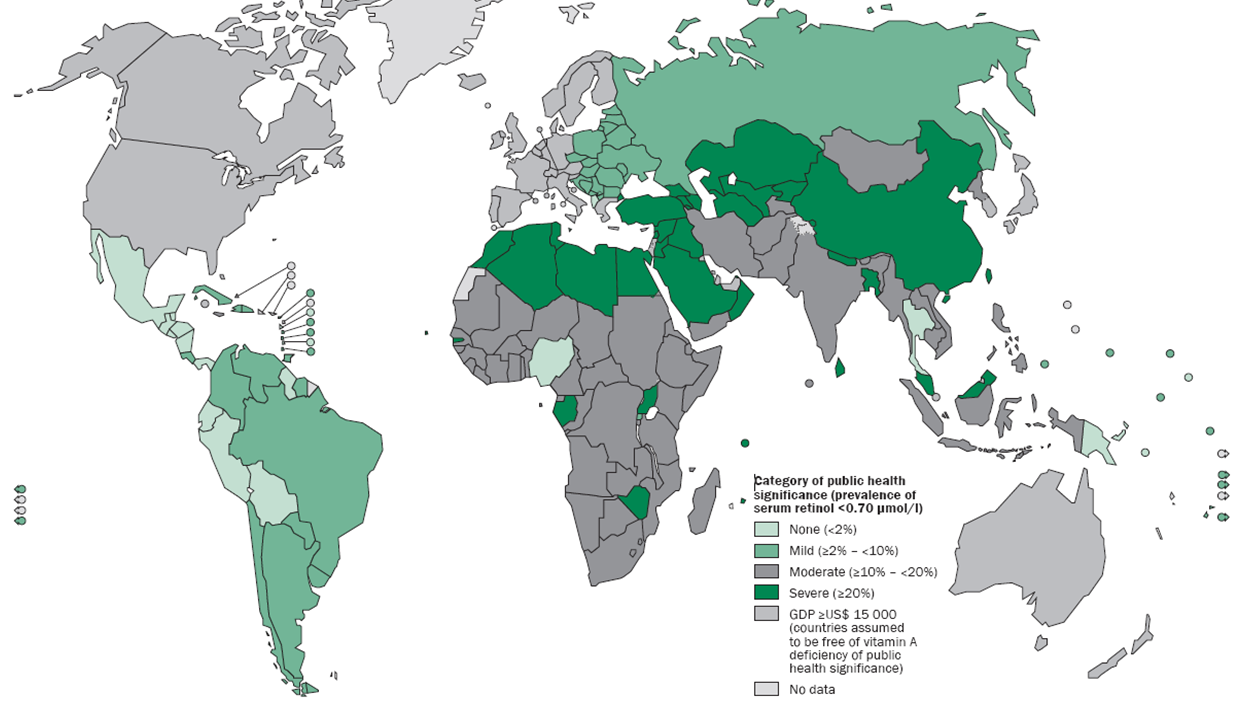|
|
| Line 25: |
Line 25: |
| | We aim to combat this tragic and preventable loss of life and quality of life by designing a strain of yeast that can produce a Vitamin A precursor, beta-carotene, that humans can convert into Vitamin A in large enough quantities so that it meets the daily required amounts. We also aim to install a Vitamin C biosynthesis pathway in yeast that can be introduced into staples that people eat and drink, such as bread and beer, at no extra cost, as yeast are already used in these processes. | | We aim to combat this tragic and preventable loss of life and quality of life by designing a strain of yeast that can produce a Vitamin A precursor, beta-carotene, that humans can convert into Vitamin A in large enough quantities so that it meets the daily required amounts. We also aim to install a Vitamin C biosynthesis pathway in yeast that can be introduced into staples that people eat and drink, such as bread and beer, at no extra cost, as yeast are already used in these processes. |
| | | | |
| - | Perhaps the most interesting facet of vitamin deficiency is that it is '''linked to a whole swath of other major public health concern'''. Let's take our cue from the World Health Organization and use their [http://www.un.org/millenniumgoals/ Millennium Development Goals] as a guide to the biggest global health problems of our generation. These include | + | Perhaps the most interesting facet of vitamin deficiency is that it is '''linked to a whole swath of other major public health concerns'''. Let's take our cue from the World Health Organization and use their [http://www.un.org/millenniumgoals/ Millennium Development Goals] as a guide to the biggest global health problems of our generation. These include |
| | | | |
| | * End poverty and hunger | | * End poverty and hunger |
| Line 34: |
Line 34: |
| | [[Image:Maternalvita.png|thumb|300px|right|A map of vitamin A deficiency among pregnant women based on serum retinol.]] | | [[Image:Maternalvita.png|thumb|300px|right|A map of vitamin A deficiency among pregnant women based on serum retinol.]] |
| | | | |
| - | '''VitaYeast addresses all four of the Millennium Development Goals listed above'''. How? VitaYeast is designed to end hunger by providing nutrients in addition to calories. VitaYeast addresses child health by delivering vitamin A to the quarter billion children who are vitamin A deficient. There is a strong connection between maternal health and vitamin deficiency. Many of the countries where the WHO is actively working on its maternal health goals show up with moderate to sever vitamin A deficiency on the plot to the right. Vitamin A deficiency in pregnant mothers leads to neural tube defects in newborns. Finally, as we will discuss below, the choice of yeast as our vitamin delivery vehicle results in an environmental impact far less than producing and transporting vitamin pills or vitamin-enriched loaves of bread. | + | '''VitaYeast addresses all four of the Millennium Development Goals listed above'''. How? VitaYeast is designed to end hunger by providing nutrients in addition to calories. VitaYeast addresses child health by delivering vitamin A to the quarter billion children who are vitamin A deficient. There is a strong connection between maternal health and vitamin deficiency. Many of the countries where the WHO is actively working on its maternal health goals show up with moderate to severe vitamin A deficiency on the plot to the right. Vitamin A deficiency in pregnant mothers leads to neural tube defects in newborns. Finally, as we will discuss below, the choice of yeast as our vitamin delivery vehicle results in an environmental impact far less than producing and transporting vitamin pills or vitamin-enriched loaves of bread. |
| | | | |
| | [[File:VitA3.jpg|thumb|left|250px|Fruits and vegetables are generally too expensive for people of impoverished countries]] | | [[File:VitA3.jpg|thumb|left|250px|Fruits and vegetables are generally too expensive for people of impoverished countries]] |
Background

The tragic faces behind the numbers
Vitamin A deficiency is a public health problem affecting more than half of all countries, most notably in Africa and South Asia. It especially affects young children and pregnant women in low-income countries. The numbers associated with this problem are staggering - 250,000,000 preschool children are Vitamin A deficient, and every year, 250,000 to 500,000 of these children become blind. Over half of them die within 12 months of the onset of blindness. It is also a major cause of maternal mortality. Another major cause of malnutrition in developing nations is Vitamin C deficiency. It is most prevalent in South Asia, in the countries of India and Pakistan.
We aim to combat this tragic and preventable loss of life and quality of life by designing a strain of yeast that can produce a Vitamin A precursor, beta-carotene, that humans can convert into Vitamin A in large enough quantities so that it meets the daily required amounts. We also aim to install a Vitamin C biosynthesis pathway in yeast that can be introduced into staples that people eat and drink, such as bread and beer, at no extra cost, as yeast are already used in these processes.
Perhaps the most interesting facet of vitamin deficiency is that it is linked to a whole swath of other major public health concerns. Let's take our cue from the World Health Organization and use their [http://www.un.org/millenniumgoals/ Millennium Development Goals] as a guide to the biggest global health problems of our generation. These include
- End poverty and hunger
- Child health
- Maternal health
- Environmental sustainability

A map of vitamin A deficiency among pregnant women based on serum retinol.
VitaYeast addresses all four of the Millennium Development Goals listed above. How? VitaYeast is designed to end hunger by providing nutrients in addition to calories. VitaYeast addresses child health by delivering vitamin A to the quarter billion children who are vitamin A deficient. There is a strong connection between maternal health and vitamin deficiency. Many of the countries where the WHO is actively working on its maternal health goals show up with moderate to severe vitamin A deficiency on the plot to the right. Vitamin A deficiency in pregnant mothers leads to neural tube defects in newborns. Finally, as we will discuss below, the choice of yeast as our vitamin delivery vehicle results in an environmental impact far less than producing and transporting vitamin pills or vitamin-enriched loaves of bread.

Fruits and vegetables are generally too expensive for people of impoverished countries
Yeast is an ideal vitamin-distribution platform. Any culture, baker, or family accustomed to baking bread already knows how to use VitaYeast! No special reagents or equipment are required to bake "VitaBread", as we have shown. VitaYeast can easily be physically delivered to remote villages since large stocks can easily growth from a small chunk of yeast living in dough called "starter". Starter can be distributed among households and bakers, allowing the strain to be delivered using existing infrastructure. Finally, unlike competing genetically-engineered vitamin delivery systems, VitaYeast is only a small part of the end product (bread) and results in no changes in color or, we believe, taste.
Another important aspect of the VitaYeast project is to be able to regulate the amount of β-carotene and Vitamin C in our final food products. As overexpressing the enzymes in our pathways to a great degree would over-stress our yeast, we need to be able to optimally regulate the amount of each vitamin in order to maintain viable yeast that is maximally beneficial to the consumer. Therefore, it is crucial to have a system by which we can measure baseline kinetic rates of enzymes and substrates/products in the cell, make modifications to our system, and measure their impact accordingly. These quantitative experiments would prove to be crucial for optimizing our yeast strains and producing maximally efficient, vitamin-producing bread.
 "
"




